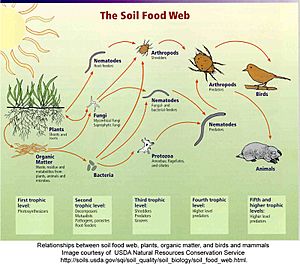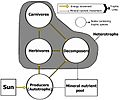Food web facts for kids
A food web is like a food chain, but much bigger and more complex. It's a diagram that shows how different plants and animals are connected by what they eat.
Think of it as a map of who eats whom in an ecosystem. Food webs show how living things depend on each other to survive. Unlike a simple food chain that follows just one path (like grass → rabbit → fox), a food web shows many different paths and connections.
For example, a tree makes acorns. The tree is called a producer because it makes its own food using sunlight. Mice, squirrels, and insects eat these acorns. Because there are many mice, animals like weasels, snakes, and raccoons have food. If insects eat the acorns, other animals like skunks or opossums might come to eat the insects. Then, bigger predators like foxes, hawks, or owls can find food by eating the skunks or opossums. Arrows in a food web show how energy moves from one living thing to another when it's eaten.
What is a Food Web?
Food webs help scientists understand the complex ways that species interact in nature. They show how energy flows through an ecosystem. For a long time, people have thought about how living things are connected.
An early idea of a food chain came from a scholar named Al-Jahiz in the Middle Ages. He wrote that all animals need food, and even a hunting animal can be hunted itself. Later, in the 1800s, scientists started drawing pictures of food webs.
A scientist named Charles Sutherland Elton helped make food webs a central idea in the study of ecology (how living things interact with their environment). He wrote about "food cycles" and "food chains" in 1927. Another scientist, Raymond Lindeman, later explained how important decomposers are. Decomposers are things like bacteria and fungi that break down dead plants and animals.
Even famous thinkers like Charles Darwin talked about the "web of life" and "complex relations" in nature.
Types of Food Webs
Food webs are simplified pictures of real ecosystems. There are millions of different species on Earth, and most of them are tiny microbes or insects. Scientists can't show every single connection, so they focus on the most important ones.
Here are some different kinds of food webs:
- Source web - This shows one or more species and all the animals that eat them, and what those animals eat, and so on.
- Sink web - This shows one or more species and all the animals they eat, and what those animals eat, and so on.
- Community web - This shows a group of species and all the connections of who eats whom.
- Energy flow web - This shows how much energy moves between species when one eats another.
- Paleoecological web - This type of web tries to figure out what ancient ecosystems looked like based on fossils.
- Functional web - This focuses on the most important connections that have a big impact on how the community is organized.
Scientists also study food webs based on where they are found. For example, there are marine food webs (in the ocean), aquatic food webs (in freshwater), soil food webs (in the ground), and microbial food webs (involving tiny living things).
Detrital Food Webs
In a detrital food web, dead plants and animals are broken down by decomposers like bacteria and fungi. These decomposers are eaten by detritivores (animals that eat decaying matter), and then those detritivores are eaten by carnivores.
Detrital webs are often connected to "grazing webs" (where living plants are eaten). For example, mushrooms are made by decomposers in a detrital web, but then deer, squirrels, and mice might eat those mushrooms. Earthworms are detritivores that eat decaying leaves, and then robins eat the earthworms.
Images for kids
-
A freshwater aquatic food web. The blue arrows show a complete food chain (algae → daphnia → gizzard shad → largemouth bass → great blue heron)
-
A simplified food web in the Gulf of Naples during different conditions.
-
Victor Summerhayes and Charles Elton's 1923 food web of Bear Island (Arrows point to an organism being consumed by another organism).
See also
 In Spanish: Red trófica para niños
In Spanish: Red trófica para niños













